Tow Bar Types
There is a lot of confusion as to what our options are, in terms of tow bar types available, and a number of misconceptions, especially where specialist hitches, such as the AL-KO hitch are involved. So. What are our actual options, and how / when can they be used?
In actual fact, all tow bar balls are the same, regardless of hitch type. They are all the standard 50mm tow ball, and have been since the late 1970’s. What does vary, depending on usage, is the way they are mounted, and, in particular, the clearance provided between the ball and the towing vehicle.
In reality, there are only, really, two main types of tow bars (although they can be sub divided into various sub categories).
The main types are;
- Flange tow bar, and
- Swan neck tow bar
Flange Tow Bar
This is the most common type of ‘standard’ tow bar in the UK, and consists of a tow bar, attached, using two 24mm bolts, to a flange plate, which is, itself, usually, permanently attached to the towing vehicle.
These tow bars are the most cost effective, and, also, the most versatile on the market, as they can be used with a large number of accessories, such as bike racks and all standard stabilisers. Other advantages include their relatively universal application, to most vehicles, their low price, and the fact that they can be height adjusted, using a drop plate.
Some flange tow bars come with removable balls for different applications, although this is not to suggest that they are quickly and easily interchangeable, and the flange tow bar is a relatively permanent set up.
The down side of this is that they are constantly on display, and, as many will know, knocking your shin on one is just marginally ahead of child birth, in the pain stakes (only without the gas and air). Also, this type of tow bar is a little wider than the swan neck type, and, therefore, more likely to trigger rear parking sensors on some cars.
The big problem with flange tow bars is that the vast majority are not suitable for use with an AL-KO stabiliser hitch. Contrary to popular misconception, this is not, actually, due to an incompatibility with the tow ball itself, it is because the flange tow bars, generally, are mounted too close to the towing vehicle, and do not give adequate clearance for use with an AL-KO hitch. also, the clearance below the tow ball may be inadequate, giving rise to further problems. In this case, you will need to consider the use of a swan neck tow bar.
Swan Neck Tow Bar
Not difficult to see where the name comes from, this type of tow bar is the most common type in the EU, but is becoming increasingly popular, here in the UK. This is, largely, down to the fact that they do look better than their cheaper counterparts, they are less likely to trigger parking sensors, and they can be used with AL-KO stabilisers, without modification.
On the down side, they are less flexible as they are not height adjustable, and cannot be used with bike racks etc (at least, not whilst towing).
They are also equally as painful when in contact with unwary shins.
Removable Tow Bars
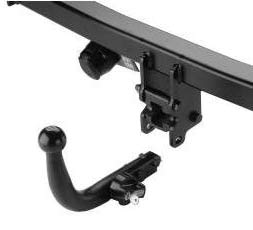
Typical Removable Swan Neck Tow Bar
Whilst it is possible to have removable flange tow bars, it is, probably, fair to say that the vast majority will be of the swan neck type, as it lends itself far better to that type of installation.
Flange tow bars can be fitted with a removable neck, which, as well as the convenience of being able to remove them, means that they can be adapted to use with and AL-KO tow hitch, unlike their non removable cousins.
Removable swan neck tow bars are far more common, and come in a variety of connection types, including vertical, horizontal and nut / pin systems. The key advantages are that they are discreet, can be removed for tight parking situations, and are far easier on the shins, once removed. Also, because they can be fully removed, there are no issues, at all, with rear parking sensors.
AL-KO Hitches
There is much speculation about whether there is a need for the use of specialist Al-Ko tow bars when using an AL-KO stabiliser hitch. The simple answer is; ‘No. we don’t need a specialist tow bar’. That said, some tow bars will not be suitable, and there are a number of things we need to be be aware of, if we are using an AL-KO stabiliser tow hitch, as opposed to a standard tow hitch.
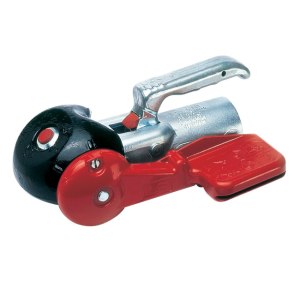
Although Appearances Will Vary, AL-KO Hitches Will Tend To Incorporate The Distinctive Red Lever, Used To Engage The Dampening Pads.
Firstly, as already mentioned above, in the main, you will be unable to use an AL-KO hitch with a standard, fixed, flange tow bar.
This has nothing to do with the size of the tow ball (this is a very common misconception, but they are all 50mm) it is, mainly, down to the clearance between the tow ball and the towing vehicle.
If the ball is too close, then the hitch will make contact with the rear bumper, causing problems ranging from damage to the vehicle / tow bar, to, in extreme cases, the detachment of the trailer unit.
The clearance needed will depend on the model of hitch used, but, for the anoraks amongst us, the minimum clearance between the centre of the tow ball and the rear bumper is shown here; AL-KO FAQs.
OK. So we know that the swan neck tow bar is likely to be the most appropriate type of tow bar, but what else do we need to consider? Well. There a number of things we need to be aware of, if using an AL-KO hitch, rather than a standard one. The AL-KO hitch attaches to the tow bar in the same way as any other hitch, however, when you activate the red lever, it engages the stabiliser pads, which grip the tow ball and provide a dampening effect on any excess movement. This means the AL-KO hitch needs very different conditions, in order to operate effectively. A standard tow hitch will move around freely, and the recommendation is that the tow ball should be well greased, in order to avoid excess wear and tear. With an AL-KO hitch, however, the situation is totally the opposite. In order to work, effectively, the pads need the tow ball to be totally clean, and free of grease. Any traces of grease should be removed, using brake cleaner or equivalent. Never use metholated spirits for this, as they will leave a greasy residue on the ball. It is, also, imperative that any and all paint is removed from the tow ball, prior to the attachment of any AL-KO hitch. This is because the pads on the hitch rub the paint, causing it to clump together in tiny balls, which then dig into the ball, scoring, or pitting it.
Whatever tow bar we do fit, though, it is important to make sure it is ‘type approved’. This means it meets EU regulations and is designed for your car. A type-approved tow bar will have a label with an approval number and details of the vehicles it’s approved for. If your car was first used before 1 August 1998, your tow bar doesn’t need to be type-approved.
Tow Bar Electrics
We can’t really look at the topic of tow bars without covering the basics of the electrics, as well. Most cars are either fitted with single, 7 pin electrics, or the dual electric system, and these will be compatible with the vast majority of folding campers, trailers and trailer tents. Most modern caravans, however, are fitted with the Euro plug system, comprising one, single, 13 pin plug and socket, and this is a system that is, currently, expanding into other forms of trailer, albeit at a far slower rate.
Single 7 Pin Electrics (12N)
This involves one single socket on the towing vehicle, and / or a single connecting lead into the trailer unit. This system will power the trailer lights, including the side / brake lights, and indicators on the trailer, and nothing else. The lead and socket are, usually, both, black.
Twin Electrics. (12N+ 12S)
This system has the same single electrics described above, but with the addition of a further lead / socket (usually grey or white) which is used to power the additional electrics in the trailer. The three main functions this will perform are to run a 12V fridge, if fitted, charge the leisure battery, again, if fitted, and operate the reversing lights on the trailer.
13 Pin Euro Plug.
This, basically, performs exactly the same functions as the twin electrics system, but it does it in one single Euro plug, with one single lead. As already mentioned, it is particularly prevalent in modern caravan manufacture.
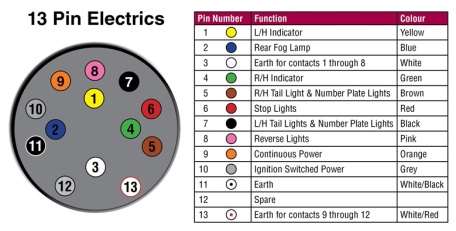
If you have either twin electrics, or the Euro plug on your car, it is possible to obtain an adaptor to run it with twin electrics or a Euro plug on the trailer. What you are unable to do is to connect a single car socket to twin / Euroelectrics, as it will still only power the rear lights.
Whether it is worth going for twin electrics or the Euro plug will, largely, depend on the nature of touring done. If you tend to travel a lot, and over long distances, especially on sites without electric hookup, then the ability to keep the fridge cool, whilst travelling (it will not work on site) and to charge the battery on the move will be invaluable. If, however, you tend to keep to shorter journeys, and always use EHU, the benefits will be less significant, and you may find that single electrics will be more than adequate.
That’s pretty much tow bars in a nut shell. Not, actually that complicated, but a few important things to be aware of, particularly if considering using an AL-KO stabiliser hitch.



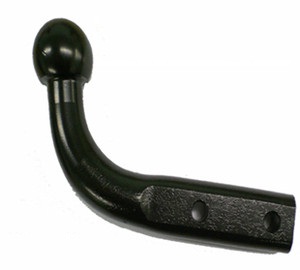

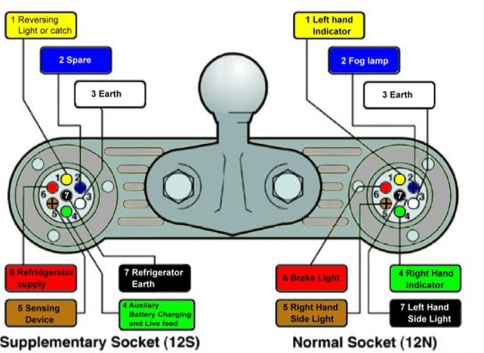





















No mention of nose loads, tow bar ratings, ball height, trailer or gross vehicle train weight.
LikeLike
Nope. None at all.
The article is titled; “Installing Tow Bars & Electrics. What Are Our Options”? It was written as a general guide, to give an idea of what the main types of tow bar are, and the different options of single, twin and Euro connections, and not as a detailed guide to all aspects of choosing, fitting and using one. The article is aimed at folding camper owners, and similar users, many of whom are just starting out. (A reasonable assumption, for the majority, if they are looking at installing a tow bar for the first time). The vast majority of our target audience will not be installing their own tow bars, and issues such as nose loads, tow bar ratings etc will be of little relevance / interest to them, at this stage, as the decision making process will be very much in its infancy. The more important aspects of towing, and the relevance of gross train weight etc are covered in separate features, geared more around towing issues and legislation, as opposed to this one, which is designed to be an entry level introduction to what the current options available on the market are, and, in layman’s terms, why we might want to choose those options.
LikeLike
Very interesting,good job and thanks for sharing such a good blog.
LikeLike
Alan thanks for all this valuable help. I’m still not sure but I think I’ll need an adaptor. I’m having the 13 pin fitted as that’s what the manufacturer of my car supplies but as I’m buying an old 2001 camper it has two leads. Not bothered about running fridge just need lights on trailer, do I need an adaptor , to join the trailer lead to the 13 pin?
LikeLike
Hi Narina. My pleasure. You will need an adaptor, anyway, to go from 13 pin to the 7 pin of the older camper, so you may as well use it for the fridge / battery charger as well.
LikeLike
Fantastic Blog! It really gives proper collaboration to understand the main theme step by step, keep it up..
Towbar fitting norwich
LikeLike